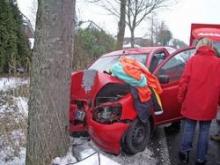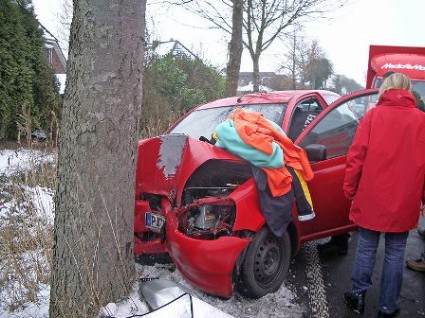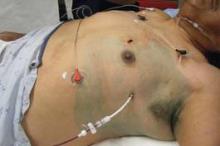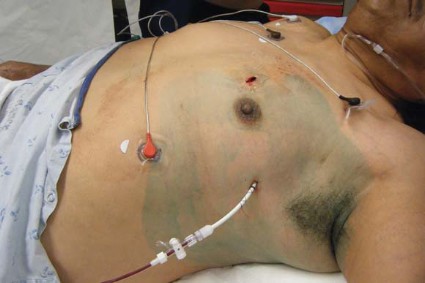User login
Over 5 L of crystalloids raises morbidity
SCOTTSDALE, ARIZ. – Morbidity increased with the use of more than 5 L of crystalloid solution during high-ratio hemostatic resuscitation, according to the results of a retrospective study of 451 trauma patients.
This is the first multicenter analysis to demonstrate the deleterious effect on morbidity in high-ratio resuscitation (HRR) patients, Dr. Juan Duchesne said at the annual scientific assembly of the Eastern Association for the Surgery of Trauma.
"These patients already have acute insult, so when you add the double-hit phenomenon of crystalloids, you are definitely jeopardizing their outcomes," said Dr. Duchesne, director of the surgical intensive care unit at Tulane University, New Orleans.
The retrospective analysis included 451 patients treated at five centers in the United States. All received at least 10 units of packed red blood cells (PBRC) over 24 hours and damage control laparotomy. Of these, 365 received fresh frozen plasma (FFP) and PRBC at a ratio of at least 1:2 (HRR); the ratio was less than 1:2 (low-ratio resuscitation) in the other 86 patients.
The average Injury Severity Score was 23.5 (on a scale of 0-75), and the average FFP:PRBC ratio was 1.06 in the HRR group and 1.32 in the low-ratio resuscitation group.
As observed in other studies, patients in the HRR group had a significant survival advantage over those in the low-resuscitation group at 24 hours (85% vs. 69%; P = .0004), Dr. Duchesne said.
In 200 HRR patients with full data, an analysis of 24-hour crystalloid volume revealed that 9.5% received less than 5 L, 25% got 5-10 L, and 65.5% got more than 10 L. The 24-hour crystalloid volume was statistically different between the three subgroups (3.64 L vs. 7.81 L vs. 17.82 L; P = .0001), but there were no statistically significant differences in mortality.
The risk of certain morbidities, however, increased with crystalloid volume in the three subgroups. Rates of bacteremia rose significantly (0% [less than 5 L]), 13% [5-10 L], and 29% [more than 10 L]; P = .029), as did sepsis (0% [less than 5 L], 13% [5-10 L], and 22% [more than 10 L]); P = .028).
The differences were not significant for acute respiratory distress syndrome (1% [less than 5 L], 0% [5-10 L], and 8% [more than 10 L]; P = .163) and for acute respiratory failure (2% [less than 5 L], 12% [5-10 L], and 24% [more than 10 L]; P = .457).
In multiple logistic regression analysis, morbidity was significantly associated with 24-hour crystalloid volume (odds ratio, 1.11; P = .001), systolic blood pressure level in the emergency department (OR, 1.19; P = .043), and base deficit level in the emergency department (OR, 1.02; P = .002). Morbidity was not associated with high ratio resuscitation (OR, 1.34; P = .065), Dr. Duchesne observed.
Dr. Duchesne reported having no disclosures.
 |
Patrice Wendling/IMNG Medical Media
|
This study elucidates the tangible evils of crystalloid. Despite more than a decade of research pointing to concern about overuse of these solutions, some practitioners have been slow to come around. But as I look at this study, I question why the choice was to focus on the sickest of the sick.
I readily acknowledge that morbidity will have its worst effects on those most susceptible, thus increasing the power of the findings, but I am curious about the decision on those patients.
Further, 100% data capture for all items analyzed was only possible for 451 patients out of 1,484 patients who received at least one unit of packed red blood cells with massive transfusion protocol activation. Thus, a high number of patients were excluded from the study, raising the possibility of erroneous conclusions due to missing data.
The increase in morbidity associated with crystalloids would likely not have been observed if the cohort included all mass transfusion patients, and eliminated the Injury Severity Score and damage control laparotomy criteria.
Dr. Donald Jenkins, is past president of the Eastern Association for the Surgery of Trauma and is with the Mayo Clinic in Rochester, Minn. He was the invited discussant for the study at the meeting and reported having no disclosures.
 |
Patrice Wendling/IMNG Medical Media
|
This study elucidates the tangible evils of crystalloid. Despite more than a decade of research pointing to concern about overuse of these solutions, some practitioners have been slow to come around. But as I look at this study, I question why the choice was to focus on the sickest of the sick.
I readily acknowledge that morbidity will have its worst effects on those most susceptible, thus increasing the power of the findings, but I am curious about the decision on those patients.
Further, 100% data capture for all items analyzed was only possible for 451 patients out of 1,484 patients who received at least one unit of packed red blood cells with massive transfusion protocol activation. Thus, a high number of patients were excluded from the study, raising the possibility of erroneous conclusions due to missing data.
The increase in morbidity associated with crystalloids would likely not have been observed if the cohort included all mass transfusion patients, and eliminated the Injury Severity Score and damage control laparotomy criteria.
Dr. Donald Jenkins, is past president of the Eastern Association for the Surgery of Trauma and is with the Mayo Clinic in Rochester, Minn. He was the invited discussant for the study at the meeting and reported having no disclosures.
 |
Patrice Wendling/IMNG Medical Media
|
This study elucidates the tangible evils of crystalloid. Despite more than a decade of research pointing to concern about overuse of these solutions, some practitioners have been slow to come around. But as I look at this study, I question why the choice was to focus on the sickest of the sick.
I readily acknowledge that morbidity will have its worst effects on those most susceptible, thus increasing the power of the findings, but I am curious about the decision on those patients.
Further, 100% data capture for all items analyzed was only possible for 451 patients out of 1,484 patients who received at least one unit of packed red blood cells with massive transfusion protocol activation. Thus, a high number of patients were excluded from the study, raising the possibility of erroneous conclusions due to missing data.
The increase in morbidity associated with crystalloids would likely not have been observed if the cohort included all mass transfusion patients, and eliminated the Injury Severity Score and damage control laparotomy criteria.
Dr. Donald Jenkins, is past president of the Eastern Association for the Surgery of Trauma and is with the Mayo Clinic in Rochester, Minn. He was the invited discussant for the study at the meeting and reported having no disclosures.
SCOTTSDALE, ARIZ. – Morbidity increased with the use of more than 5 L of crystalloid solution during high-ratio hemostatic resuscitation, according to the results of a retrospective study of 451 trauma patients.
This is the first multicenter analysis to demonstrate the deleterious effect on morbidity in high-ratio resuscitation (HRR) patients, Dr. Juan Duchesne said at the annual scientific assembly of the Eastern Association for the Surgery of Trauma.
"These patients already have acute insult, so when you add the double-hit phenomenon of crystalloids, you are definitely jeopardizing their outcomes," said Dr. Duchesne, director of the surgical intensive care unit at Tulane University, New Orleans.
The retrospective analysis included 451 patients treated at five centers in the United States. All received at least 10 units of packed red blood cells (PBRC) over 24 hours and damage control laparotomy. Of these, 365 received fresh frozen plasma (FFP) and PRBC at a ratio of at least 1:2 (HRR); the ratio was less than 1:2 (low-ratio resuscitation) in the other 86 patients.
The average Injury Severity Score was 23.5 (on a scale of 0-75), and the average FFP:PRBC ratio was 1.06 in the HRR group and 1.32 in the low-ratio resuscitation group.
As observed in other studies, patients in the HRR group had a significant survival advantage over those in the low-resuscitation group at 24 hours (85% vs. 69%; P = .0004), Dr. Duchesne said.
In 200 HRR patients with full data, an analysis of 24-hour crystalloid volume revealed that 9.5% received less than 5 L, 25% got 5-10 L, and 65.5% got more than 10 L. The 24-hour crystalloid volume was statistically different between the three subgroups (3.64 L vs. 7.81 L vs. 17.82 L; P = .0001), but there were no statistically significant differences in mortality.
The risk of certain morbidities, however, increased with crystalloid volume in the three subgroups. Rates of bacteremia rose significantly (0% [less than 5 L]), 13% [5-10 L], and 29% [more than 10 L]; P = .029), as did sepsis (0% [less than 5 L], 13% [5-10 L], and 22% [more than 10 L]); P = .028).
The differences were not significant for acute respiratory distress syndrome (1% [less than 5 L], 0% [5-10 L], and 8% [more than 10 L]; P = .163) and for acute respiratory failure (2% [less than 5 L], 12% [5-10 L], and 24% [more than 10 L]; P = .457).
In multiple logistic regression analysis, morbidity was significantly associated with 24-hour crystalloid volume (odds ratio, 1.11; P = .001), systolic blood pressure level in the emergency department (OR, 1.19; P = .043), and base deficit level in the emergency department (OR, 1.02; P = .002). Morbidity was not associated with high ratio resuscitation (OR, 1.34; P = .065), Dr. Duchesne observed.
Dr. Duchesne reported having no disclosures.
SCOTTSDALE, ARIZ. – Morbidity increased with the use of more than 5 L of crystalloid solution during high-ratio hemostatic resuscitation, according to the results of a retrospective study of 451 trauma patients.
This is the first multicenter analysis to demonstrate the deleterious effect on morbidity in high-ratio resuscitation (HRR) patients, Dr. Juan Duchesne said at the annual scientific assembly of the Eastern Association for the Surgery of Trauma.
"These patients already have acute insult, so when you add the double-hit phenomenon of crystalloids, you are definitely jeopardizing their outcomes," said Dr. Duchesne, director of the surgical intensive care unit at Tulane University, New Orleans.
The retrospective analysis included 451 patients treated at five centers in the United States. All received at least 10 units of packed red blood cells (PBRC) over 24 hours and damage control laparotomy. Of these, 365 received fresh frozen plasma (FFP) and PRBC at a ratio of at least 1:2 (HRR); the ratio was less than 1:2 (low-ratio resuscitation) in the other 86 patients.
The average Injury Severity Score was 23.5 (on a scale of 0-75), and the average FFP:PRBC ratio was 1.06 in the HRR group and 1.32 in the low-ratio resuscitation group.
As observed in other studies, patients in the HRR group had a significant survival advantage over those in the low-resuscitation group at 24 hours (85% vs. 69%; P = .0004), Dr. Duchesne said.
In 200 HRR patients with full data, an analysis of 24-hour crystalloid volume revealed that 9.5% received less than 5 L, 25% got 5-10 L, and 65.5% got more than 10 L. The 24-hour crystalloid volume was statistically different between the three subgroups (3.64 L vs. 7.81 L vs. 17.82 L; P = .0001), but there were no statistically significant differences in mortality.
The risk of certain morbidities, however, increased with crystalloid volume in the three subgroups. Rates of bacteremia rose significantly (0% [less than 5 L]), 13% [5-10 L], and 29% [more than 10 L]; P = .029), as did sepsis (0% [less than 5 L], 13% [5-10 L], and 22% [more than 10 L]); P = .028).
The differences were not significant for acute respiratory distress syndrome (1% [less than 5 L], 0% [5-10 L], and 8% [more than 10 L]; P = .163) and for acute respiratory failure (2% [less than 5 L], 12% [5-10 L], and 24% [more than 10 L]; P = .457).
In multiple logistic regression analysis, morbidity was significantly associated with 24-hour crystalloid volume (odds ratio, 1.11; P = .001), systolic blood pressure level in the emergency department (OR, 1.19; P = .043), and base deficit level in the emergency department (OR, 1.02; P = .002). Morbidity was not associated with high ratio resuscitation (OR, 1.34; P = .065), Dr. Duchesne observed.
Dr. Duchesne reported having no disclosures.
AT THE EAST SCIENTIFIC ASSEMBLY
Major finding: With a rise in the volume of crystalloid solutions, rates of sepsis rose significantly (0% [less than 5 L], 13% [5-10 L], 22% [more than 10 L]); P = .028).
Data source: Retrospective multicenter analysis of 451 patients undergoing hemostatic resuscitation.
Disclosures: Dr. Duchesne and Dr. Jenkins reported having no disclosures.
Hypercoagulability occurred despite VTE prophylaxis in burn patients
SCOTTSDALE, ARIZ. – Despite thromboprophylaxis, burn patients become hypercoagulable during recovery, putting them at increased risk of venous thromboembolism, a small, prospective study has shown.
"The hypercoagulable state is likely multifactorial, and we believe that additional prophylaxis and monitoring may be needed," Dr. Robert Van Haren said at the annual scientific assembly of the Eastern Association for the Surgery of Trauma.
Hypercoagulability has long been known to contribute to venous thromboembolism (VTE), but it’s only more recently that the increased incidence of thromboembolic complications in burn patients has been appreciated.
A study using duplex ultrasound screening reported that 23% of burn patients developed deep venous thrombosis at an average of 6.7 days after admission (J. Burn Care Rehabil. 2002;23:439-43).
More recent work reports that such in-hospital risk factors as number of operations, pneumonia, and central venous access are significantly associated with VTE after thermal injury (J. Burn Care Res. 2012;33:84-8).
Dr. Van Haren and his colleagues at the University of Miami used thromboelastography (TEG) and coagulation tests to analyze blood samples drawn from indwelling catheters upon admission and at 1 week in 24 patients. All patients were placed on unfractionated or low-molecular-weight heparin at admission.
Their median age was 49 years, 88% were male, and the median total body surface area burned was 29%. Inhalation injuries also were present in 17%.
TEG values were within normal limits at admission for clotting time (R = 11.5 minutes), initial clot formation (K = 2.8 minutes), clot kinetics (alpha angle = 54.6 degrees), and clot strength (maximum amplitude = 62.5 mm).
Repeat TEG at 1 week in 16 patients who remained hospitalized revealed significantly decreased R (8.3 minutes) and K (2.0 minutes) times, and elevated alpha angle (65.5 degrees) and maximum amplitude (73.1 mm; all statistically significant, P less than .05).
"All of these changes demonstrate that these patients became more hypercoagulable at week 1," said Dr. Van Haren, a 4th-year general surgery resident.
Coagulation tests were generally supportive of TEG findings. From admission to week 1, significant decreases were observed in median prothrombin time (17.4 seconds vs. 15.7 seconds; P = .013) and international normalized ratio (1.47 vs. 1.28; P = .013). At the same time, significant elevations occurred in protein C activity (75% vs. 93%; P = .017), protein S activity (69% vs. 76%; P = .030), antithrombin III (62% vs. 88%; P = .005), and fibrinogen (524 mg/dL vs. 676 mg/dL; P = .047).
The changes suggest a procoagulant state, and cannot be attributed to hemoconcentration, as fluid balance was more positive and hematocrit was lower on repeat samples, Dr. Van Haren reported.
The only in-hospital risk factor significant for hypercoagulability at 1 week was a pre-TEG operation, he said. Men, however, were more likely to be hypercoagulable than women.
Two patients, both male, developed a deep venous thrombosis. Contrary to previous studies, the only predictive markers of VTE were decreased partial thromboplastin time and fibrinogen and elevated prothrombin fragment 1 + 2.
During the discussion period after Dr. Van Haren’s presentation, audience members asked why hypercoagulability was evaluated at 1 week, since hypercoagulability has been shown to develop quite rapidly in trauma patients. Other questions addressed whether clinicians should use the data to increase thromboprophylaxis or begin dosing based on body mass index in burn patients.
Dr. Van Haren said the 1-week time point was somewhat arbitrary, and plans to look at earlier time periods in another cohort to determine exactly when the transition to hypercoagulability occurs. "I think the most interesting thing would be to see if you can guide your thromboprophylaxis based on TEG, and use it to titrate your dose to see if it will result in decreases in VTE rates."
The study was funded in part by grants from the Office of Naval Research and U.S. Army. Dr. Van Haren and his coauthors reported no relevant financial conflicts.
SCOTTSDALE, ARIZ. – Despite thromboprophylaxis, burn patients become hypercoagulable during recovery, putting them at increased risk of venous thromboembolism, a small, prospective study has shown.
"The hypercoagulable state is likely multifactorial, and we believe that additional prophylaxis and monitoring may be needed," Dr. Robert Van Haren said at the annual scientific assembly of the Eastern Association for the Surgery of Trauma.
Hypercoagulability has long been known to contribute to venous thromboembolism (VTE), but it’s only more recently that the increased incidence of thromboembolic complications in burn patients has been appreciated.
A study using duplex ultrasound screening reported that 23% of burn patients developed deep venous thrombosis at an average of 6.7 days after admission (J. Burn Care Rehabil. 2002;23:439-43).
More recent work reports that such in-hospital risk factors as number of operations, pneumonia, and central venous access are significantly associated with VTE after thermal injury (J. Burn Care Res. 2012;33:84-8).
Dr. Van Haren and his colleagues at the University of Miami used thromboelastography (TEG) and coagulation tests to analyze blood samples drawn from indwelling catheters upon admission and at 1 week in 24 patients. All patients were placed on unfractionated or low-molecular-weight heparin at admission.
Their median age was 49 years, 88% were male, and the median total body surface area burned was 29%. Inhalation injuries also were present in 17%.
TEG values were within normal limits at admission for clotting time (R = 11.5 minutes), initial clot formation (K = 2.8 minutes), clot kinetics (alpha angle = 54.6 degrees), and clot strength (maximum amplitude = 62.5 mm).
Repeat TEG at 1 week in 16 patients who remained hospitalized revealed significantly decreased R (8.3 minutes) and K (2.0 minutes) times, and elevated alpha angle (65.5 degrees) and maximum amplitude (73.1 mm; all statistically significant, P less than .05).
"All of these changes demonstrate that these patients became more hypercoagulable at week 1," said Dr. Van Haren, a 4th-year general surgery resident.
Coagulation tests were generally supportive of TEG findings. From admission to week 1, significant decreases were observed in median prothrombin time (17.4 seconds vs. 15.7 seconds; P = .013) and international normalized ratio (1.47 vs. 1.28; P = .013). At the same time, significant elevations occurred in protein C activity (75% vs. 93%; P = .017), protein S activity (69% vs. 76%; P = .030), antithrombin III (62% vs. 88%; P = .005), and fibrinogen (524 mg/dL vs. 676 mg/dL; P = .047).
The changes suggest a procoagulant state, and cannot be attributed to hemoconcentration, as fluid balance was more positive and hematocrit was lower on repeat samples, Dr. Van Haren reported.
The only in-hospital risk factor significant for hypercoagulability at 1 week was a pre-TEG operation, he said. Men, however, were more likely to be hypercoagulable than women.
Two patients, both male, developed a deep venous thrombosis. Contrary to previous studies, the only predictive markers of VTE were decreased partial thromboplastin time and fibrinogen and elevated prothrombin fragment 1 + 2.
During the discussion period after Dr. Van Haren’s presentation, audience members asked why hypercoagulability was evaluated at 1 week, since hypercoagulability has been shown to develop quite rapidly in trauma patients. Other questions addressed whether clinicians should use the data to increase thromboprophylaxis or begin dosing based on body mass index in burn patients.
Dr. Van Haren said the 1-week time point was somewhat arbitrary, and plans to look at earlier time periods in another cohort to determine exactly when the transition to hypercoagulability occurs. "I think the most interesting thing would be to see if you can guide your thromboprophylaxis based on TEG, and use it to titrate your dose to see if it will result in decreases in VTE rates."
The study was funded in part by grants from the Office of Naval Research and U.S. Army. Dr. Van Haren and his coauthors reported no relevant financial conflicts.
SCOTTSDALE, ARIZ. – Despite thromboprophylaxis, burn patients become hypercoagulable during recovery, putting them at increased risk of venous thromboembolism, a small, prospective study has shown.
"The hypercoagulable state is likely multifactorial, and we believe that additional prophylaxis and monitoring may be needed," Dr. Robert Van Haren said at the annual scientific assembly of the Eastern Association for the Surgery of Trauma.
Hypercoagulability has long been known to contribute to venous thromboembolism (VTE), but it’s only more recently that the increased incidence of thromboembolic complications in burn patients has been appreciated.
A study using duplex ultrasound screening reported that 23% of burn patients developed deep venous thrombosis at an average of 6.7 days after admission (J. Burn Care Rehabil. 2002;23:439-43).
More recent work reports that such in-hospital risk factors as number of operations, pneumonia, and central venous access are significantly associated with VTE after thermal injury (J. Burn Care Res. 2012;33:84-8).
Dr. Van Haren and his colleagues at the University of Miami used thromboelastography (TEG) and coagulation tests to analyze blood samples drawn from indwelling catheters upon admission and at 1 week in 24 patients. All patients were placed on unfractionated or low-molecular-weight heparin at admission.
Their median age was 49 years, 88% were male, and the median total body surface area burned was 29%. Inhalation injuries also were present in 17%.
TEG values were within normal limits at admission for clotting time (R = 11.5 minutes), initial clot formation (K = 2.8 minutes), clot kinetics (alpha angle = 54.6 degrees), and clot strength (maximum amplitude = 62.5 mm).
Repeat TEG at 1 week in 16 patients who remained hospitalized revealed significantly decreased R (8.3 minutes) and K (2.0 minutes) times, and elevated alpha angle (65.5 degrees) and maximum amplitude (73.1 mm; all statistically significant, P less than .05).
"All of these changes demonstrate that these patients became more hypercoagulable at week 1," said Dr. Van Haren, a 4th-year general surgery resident.
Coagulation tests were generally supportive of TEG findings. From admission to week 1, significant decreases were observed in median prothrombin time (17.4 seconds vs. 15.7 seconds; P = .013) and international normalized ratio (1.47 vs. 1.28; P = .013). At the same time, significant elevations occurred in protein C activity (75% vs. 93%; P = .017), protein S activity (69% vs. 76%; P = .030), antithrombin III (62% vs. 88%; P = .005), and fibrinogen (524 mg/dL vs. 676 mg/dL; P = .047).
The changes suggest a procoagulant state, and cannot be attributed to hemoconcentration, as fluid balance was more positive and hematocrit was lower on repeat samples, Dr. Van Haren reported.
The only in-hospital risk factor significant for hypercoagulability at 1 week was a pre-TEG operation, he said. Men, however, were more likely to be hypercoagulable than women.
Two patients, both male, developed a deep venous thrombosis. Contrary to previous studies, the only predictive markers of VTE were decreased partial thromboplastin time and fibrinogen and elevated prothrombin fragment 1 + 2.
During the discussion period after Dr. Van Haren’s presentation, audience members asked why hypercoagulability was evaluated at 1 week, since hypercoagulability has been shown to develop quite rapidly in trauma patients. Other questions addressed whether clinicians should use the data to increase thromboprophylaxis or begin dosing based on body mass index in burn patients.
Dr. Van Haren said the 1-week time point was somewhat arbitrary, and plans to look at earlier time periods in another cohort to determine exactly when the transition to hypercoagulability occurs. "I think the most interesting thing would be to see if you can guide your thromboprophylaxis based on TEG, and use it to titrate your dose to see if it will result in decreases in VTE rates."
The study was funded in part by grants from the Office of Naval Research and U.S. Army. Dr. Van Haren and his coauthors reported no relevant financial conflicts.
AT THE EAST SCIENTIFIC ASSEMBLY
Major Finding: Repeat TEG at 1 week in 16 hospitalized burn patients revealed significantly decreased clotting (8.3 minutes) and initial clot formation (2.0 minutes) times, and elevated alpha angle (65.5 degrees) and maximum amplitude (73.1 mm; all statistically significant, P less than .05).
Data Source: A prospective study of 24 patients with thermal injuries.
Disclosures: The study was funded in part by grants from the Office of Naval Research and U.S. Army. Dr. Van Haren and his coauthors reported no relevant financial conflicts.
Direct peritoneal resuscitation beneficial after damage control surgery
SCOTTSDALE, ARIZ. – Direct peritoneal resuscitation with 2.5% Delflex solution significantly reduced abdominal closure time and operative complications in patients with hemorrhagic shock undergoing damage control surgery, a prospective case-control study showed.
The time to definitive wound closure fell from 5.7 days with standard resuscitation to 3.6 days with the addition of direct peritoneal resuscitation (DPR) with 2.5% Delflex solution (P = .006).
In addition, the control group was 3.2 times more likely to develop an intra-abdominal complication than was the DPR group (odds ratio, 3.2; P = .03), Dr. Jason W. Smith reported at the annual scientific assembly of the Eastern Association for the Surgery of Trauma..
"DPR is a safe, simple, and inexpensive method of managing an open abdomen following damage control surgery," he said. "DPR may attenuate persistent hepatic injury following hemorrhagic shock."
Dr. Smith and his colleagues at the University of Louisville (Ky.) have been strong proponents of the technique, and previously reported that DPR with Delflex shortened abdominal closure by 2.7 days in a retrospective proof-of-concept study in 19 trauma patients (J. Am. Coll. Surg. 2010;210:658-67).
Vasodilators and heparin can be used to augment microvascular circulation and prevent blood clots, but in patients with hemorrhagic shock, this generally leads to bad results. Activated drotrecogin alfa (Xigris), which was pulled from the market in October 2011, was initially used, but the sepsis drug treats only the symptoms, Dr. Smith explained.
"We selected Delflex because of its ability to have an effect on microvascular permeability as well as microvascular blood flow," he said. "So really this is a new take on what is a very old medicine."
Between 2008 and 2011, the investigators prospectively enrolled 42 patients who underwent damage control surgery and conventional resuscitation plus DPR consisting of peritoneal lavage with an 800-mL bolus of 2.5% Delflex for the first hour and a 400-mL/hr infusion thereafter. A 19 Fr drain was placed along the root of the mesentery into the pelvis, and suction dressing was applied to drain fluid. The infusion was stopped when the abdomen was closed definitively either by primary closure or by the use of an absorbable or a biologic mesh.
The patients (average age, 30.6 years) were propensity matched against 42 case controls (average age, 29.1 years) who had undergone conventional resuscitation at the discretion of the treating surgeon after damage control surgery. All patients underwent blood product resuscitation in the first 24-48 hours of treatment.
The average Injury Severity Score was 19 among patients and 21 among controls. The hepatic Abbreviated Injury Scale (AIS) score was 3.4 in both groups, and roughly 40% of patients underwent a liver operation.
Control patients had significantly elevated alanine transaminase levels at 48 (731 vs. 507 U/L) and 72 hours (791 vs. 501 U/L) post resuscitation, compared with DPR patients, and this difference continued up to 14 days after the initial injury (all P less than .01), Dr. Smith said.
International normalized ratio (INR) levels were persistently higher in the control group, reaching statistical significance at 72 hours (1.3 vs. 1.8; P = .03). Time to INR normalization was no different whether the red blood cell to fresh frozen plasma (FFP) ratio was 1:1 or 1:2, he said.
Controls achieved a slightly better transfusion ratio (1.57 vs. 1.76; P = .52), although DPR patients had significantly lower FFP requirements after 48 hours (P = .04), and received significantly fewer transfusions at 72 hours post admission (31 vs. 41; P = .007).
As observed in the pilot study, the primary fascial closure rate was significantly higher with DPR than conventional resuscitation alone (88% vs. 66%; P = .01), and mortality was similar (10% vs. 17%; P = .25), Dr. Smith said. There were no complications with DPR administration.
In a multivariate analysis, the two strongest predictors of persistent hepatic injury following hemorrhagic shock were hepatic AIS greater than 3 (OR, 3.18), followed by nonutilization of DPR (OR, 0.63).
Invited discussant Dr. Greta Piper of Yale University, New Haven, Conn., asked whether the results would have been even better with a higher infusion rate or concentration of Delflex since one effect of the infusion is continuous dialysis, with a potential reduction in total body salt and water content.
Dr. Smith replied that they have tried DPR with other agents such as mannitol and Delflex 1.5% and 4.25%, but said the 2.5% concentration "is kind of a Goldilocks dose," as 1.5% is too weak to do anything and 4.25% desiccates the intravascular space.
"The 2.5% doesn’t desiccate the intravascular space, but you still get all the benefits of microvascular augmentation," he added.
Dr. Smith noted that DPR with 2.5% Delflex has produced similar results in patients undergoing emergency surgery as well as in those with intestinal obstruction and significant bowel edema. The researchers are currently enrolling adult trauma patients into a prospective randomized trial that will evaluate changes in hepatic blood flow as well as the effect of DPR on the inflammatory process following hemorrhagic shock.
The National Institute of General Medicine Sciences supported this research. Dr. Smith and his coauthors reported no relevant financial disclosures.
SCOTTSDALE, ARIZ. – Direct peritoneal resuscitation with 2.5% Delflex solution significantly reduced abdominal closure time and operative complications in patients with hemorrhagic shock undergoing damage control surgery, a prospective case-control study showed.
The time to definitive wound closure fell from 5.7 days with standard resuscitation to 3.6 days with the addition of direct peritoneal resuscitation (DPR) with 2.5% Delflex solution (P = .006).
In addition, the control group was 3.2 times more likely to develop an intra-abdominal complication than was the DPR group (odds ratio, 3.2; P = .03), Dr. Jason W. Smith reported at the annual scientific assembly of the Eastern Association for the Surgery of Trauma..
"DPR is a safe, simple, and inexpensive method of managing an open abdomen following damage control surgery," he said. "DPR may attenuate persistent hepatic injury following hemorrhagic shock."
Dr. Smith and his colleagues at the University of Louisville (Ky.) have been strong proponents of the technique, and previously reported that DPR with Delflex shortened abdominal closure by 2.7 days in a retrospective proof-of-concept study in 19 trauma patients (J. Am. Coll. Surg. 2010;210:658-67).
Vasodilators and heparin can be used to augment microvascular circulation and prevent blood clots, but in patients with hemorrhagic shock, this generally leads to bad results. Activated drotrecogin alfa (Xigris), which was pulled from the market in October 2011, was initially used, but the sepsis drug treats only the symptoms, Dr. Smith explained.
"We selected Delflex because of its ability to have an effect on microvascular permeability as well as microvascular blood flow," he said. "So really this is a new take on what is a very old medicine."
Between 2008 and 2011, the investigators prospectively enrolled 42 patients who underwent damage control surgery and conventional resuscitation plus DPR consisting of peritoneal lavage with an 800-mL bolus of 2.5% Delflex for the first hour and a 400-mL/hr infusion thereafter. A 19 Fr drain was placed along the root of the mesentery into the pelvis, and suction dressing was applied to drain fluid. The infusion was stopped when the abdomen was closed definitively either by primary closure or by the use of an absorbable or a biologic mesh.
The patients (average age, 30.6 years) were propensity matched against 42 case controls (average age, 29.1 years) who had undergone conventional resuscitation at the discretion of the treating surgeon after damage control surgery. All patients underwent blood product resuscitation in the first 24-48 hours of treatment.
The average Injury Severity Score was 19 among patients and 21 among controls. The hepatic Abbreviated Injury Scale (AIS) score was 3.4 in both groups, and roughly 40% of patients underwent a liver operation.
Control patients had significantly elevated alanine transaminase levels at 48 (731 vs. 507 U/L) and 72 hours (791 vs. 501 U/L) post resuscitation, compared with DPR patients, and this difference continued up to 14 days after the initial injury (all P less than .01), Dr. Smith said.
International normalized ratio (INR) levels were persistently higher in the control group, reaching statistical significance at 72 hours (1.3 vs. 1.8; P = .03). Time to INR normalization was no different whether the red blood cell to fresh frozen plasma (FFP) ratio was 1:1 or 1:2, he said.
Controls achieved a slightly better transfusion ratio (1.57 vs. 1.76; P = .52), although DPR patients had significantly lower FFP requirements after 48 hours (P = .04), and received significantly fewer transfusions at 72 hours post admission (31 vs. 41; P = .007).
As observed in the pilot study, the primary fascial closure rate was significantly higher with DPR than conventional resuscitation alone (88% vs. 66%; P = .01), and mortality was similar (10% vs. 17%; P = .25), Dr. Smith said. There were no complications with DPR administration.
In a multivariate analysis, the two strongest predictors of persistent hepatic injury following hemorrhagic shock were hepatic AIS greater than 3 (OR, 3.18), followed by nonutilization of DPR (OR, 0.63).
Invited discussant Dr. Greta Piper of Yale University, New Haven, Conn., asked whether the results would have been even better with a higher infusion rate or concentration of Delflex since one effect of the infusion is continuous dialysis, with a potential reduction in total body salt and water content.
Dr. Smith replied that they have tried DPR with other agents such as mannitol and Delflex 1.5% and 4.25%, but said the 2.5% concentration "is kind of a Goldilocks dose," as 1.5% is too weak to do anything and 4.25% desiccates the intravascular space.
"The 2.5% doesn’t desiccate the intravascular space, but you still get all the benefits of microvascular augmentation," he added.
Dr. Smith noted that DPR with 2.5% Delflex has produced similar results in patients undergoing emergency surgery as well as in those with intestinal obstruction and significant bowel edema. The researchers are currently enrolling adult trauma patients into a prospective randomized trial that will evaluate changes in hepatic blood flow as well as the effect of DPR on the inflammatory process following hemorrhagic shock.
The National Institute of General Medicine Sciences supported this research. Dr. Smith and his coauthors reported no relevant financial disclosures.
SCOTTSDALE, ARIZ. – Direct peritoneal resuscitation with 2.5% Delflex solution significantly reduced abdominal closure time and operative complications in patients with hemorrhagic shock undergoing damage control surgery, a prospective case-control study showed.
The time to definitive wound closure fell from 5.7 days with standard resuscitation to 3.6 days with the addition of direct peritoneal resuscitation (DPR) with 2.5% Delflex solution (P = .006).
In addition, the control group was 3.2 times more likely to develop an intra-abdominal complication than was the DPR group (odds ratio, 3.2; P = .03), Dr. Jason W. Smith reported at the annual scientific assembly of the Eastern Association for the Surgery of Trauma..
"DPR is a safe, simple, and inexpensive method of managing an open abdomen following damage control surgery," he said. "DPR may attenuate persistent hepatic injury following hemorrhagic shock."
Dr. Smith and his colleagues at the University of Louisville (Ky.) have been strong proponents of the technique, and previously reported that DPR with Delflex shortened abdominal closure by 2.7 days in a retrospective proof-of-concept study in 19 trauma patients (J. Am. Coll. Surg. 2010;210:658-67).
Vasodilators and heparin can be used to augment microvascular circulation and prevent blood clots, but in patients with hemorrhagic shock, this generally leads to bad results. Activated drotrecogin alfa (Xigris), which was pulled from the market in October 2011, was initially used, but the sepsis drug treats only the symptoms, Dr. Smith explained.
"We selected Delflex because of its ability to have an effect on microvascular permeability as well as microvascular blood flow," he said. "So really this is a new take on what is a very old medicine."
Between 2008 and 2011, the investigators prospectively enrolled 42 patients who underwent damage control surgery and conventional resuscitation plus DPR consisting of peritoneal lavage with an 800-mL bolus of 2.5% Delflex for the first hour and a 400-mL/hr infusion thereafter. A 19 Fr drain was placed along the root of the mesentery into the pelvis, and suction dressing was applied to drain fluid. The infusion was stopped when the abdomen was closed definitively either by primary closure or by the use of an absorbable or a biologic mesh.
The patients (average age, 30.6 years) were propensity matched against 42 case controls (average age, 29.1 years) who had undergone conventional resuscitation at the discretion of the treating surgeon after damage control surgery. All patients underwent blood product resuscitation in the first 24-48 hours of treatment.
The average Injury Severity Score was 19 among patients and 21 among controls. The hepatic Abbreviated Injury Scale (AIS) score was 3.4 in both groups, and roughly 40% of patients underwent a liver operation.
Control patients had significantly elevated alanine transaminase levels at 48 (731 vs. 507 U/L) and 72 hours (791 vs. 501 U/L) post resuscitation, compared with DPR patients, and this difference continued up to 14 days after the initial injury (all P less than .01), Dr. Smith said.
International normalized ratio (INR) levels were persistently higher in the control group, reaching statistical significance at 72 hours (1.3 vs. 1.8; P = .03). Time to INR normalization was no different whether the red blood cell to fresh frozen plasma (FFP) ratio was 1:1 or 1:2, he said.
Controls achieved a slightly better transfusion ratio (1.57 vs. 1.76; P = .52), although DPR patients had significantly lower FFP requirements after 48 hours (P = .04), and received significantly fewer transfusions at 72 hours post admission (31 vs. 41; P = .007).
As observed in the pilot study, the primary fascial closure rate was significantly higher with DPR than conventional resuscitation alone (88% vs. 66%; P = .01), and mortality was similar (10% vs. 17%; P = .25), Dr. Smith said. There were no complications with DPR administration.
In a multivariate analysis, the two strongest predictors of persistent hepatic injury following hemorrhagic shock were hepatic AIS greater than 3 (OR, 3.18), followed by nonutilization of DPR (OR, 0.63).
Invited discussant Dr. Greta Piper of Yale University, New Haven, Conn., asked whether the results would have been even better with a higher infusion rate or concentration of Delflex since one effect of the infusion is continuous dialysis, with a potential reduction in total body salt and water content.
Dr. Smith replied that they have tried DPR with other agents such as mannitol and Delflex 1.5% and 4.25%, but said the 2.5% concentration "is kind of a Goldilocks dose," as 1.5% is too weak to do anything and 4.25% desiccates the intravascular space.
"The 2.5% doesn’t desiccate the intravascular space, but you still get all the benefits of microvascular augmentation," he added.
Dr. Smith noted that DPR with 2.5% Delflex has produced similar results in patients undergoing emergency surgery as well as in those with intestinal obstruction and significant bowel edema. The researchers are currently enrolling adult trauma patients into a prospective randomized trial that will evaluate changes in hepatic blood flow as well as the effect of DPR on the inflammatory process following hemorrhagic shock.
The National Institute of General Medicine Sciences supported this research. Dr. Smith and his coauthors reported no relevant financial disclosures.
AT THE EAST SCIENTIFIC ASSEMBLY
Major Finding: Time to definitive wound closure was 5.7 days with standard resuscitation vs. 3.6 days with the addition of direct peritoneal resuscitation with 2.5% Delflex (P = .006).
Data Source: Prospective, case-control study in 84 patients with hemorrhagic shock undergoing damage control surgery.
Disclosures: The National Institute of General Medicine Sciences supported this research. Dr. Smith and his coauthors reported no relevant financial disclosures.
Massachusetts ED docs reporting impaired drivers to the state
Boston emergency department physicians are now reporting impaired motorists for possible driver’s license revocation.
Over a 16-month period, 31% of admitted drivers were impaired. Of these, 17 were considered medically unqualified to drive, and 86 needed further medical evaluation.
"The vast majority of patients believe they’ll be reported [to authorities] if they arrive at the hospital impaired or under the influence, but that is not the case in Massachusetts, or in most other states from what we’ve found," according to trauma surgeon Eric Mahoney, who helped develop the reporting protocol.
Many health care personnel resist such reporting because they fear a lawsuit or retaliation. The Massachusetts Safe Driving Law of 2010 has changed the landscape by expanding the ability of health care providers and law enforcement to report drivers whom the health care providers believe are unfit to drive because of cognitive or functional impairment. The reports are sent to the Registry of Motor Vehicles (RMV), not the police.
"This has never been meant to be punitive," noted Dr. Mahoney of the department of trauma and emergency services at Boston Medical Center.
The intent has always been to get impaired drivers to visit their physicians to adjust their medication if needed, reevaluate their medical condition, or, if impairment results from substance abuse, counsel them. It’s been shown that the more contact patients have with health care, the more successful they will be at managing their health problems, he said at the annual scientific assembly of the Eastern Association for the Surgery of Trauma (EAST).
The protocol may also reduce motor vehicle crashes by having recidivists held accountable for their actions.
"In our state, the acquittal rate is close to 90% for first-time DUI offenders, so we know the current system in place really isn’t working," according to study coauthor Lisa Allee, Boston Medical Center’s injury prevention coordinator. "So our goal is to reduce recidivism and get people the help they need," she said.
Dr. Mahoney and his colleagues used the Massachusetts RMV definition of impaired driving and vetted HIPPA compliance through the hospital’s legal department. A physician can request that the RMV medical advisory board seek medical evaluation of a driver when the physician has a good faith belief of impairment based on personal observation, physical examinations, or laboratory studies. The request cannot be based on driver age or previous diagnosis.
When the accident involves substance abuse, reporting is limited to instances of a "violent/high risk" to the public such as driving in the wrong direction of traffic, speed exceeding 55 mph, having a child or loaded firearm in the car, or fleeing from police
In the 16-month study period, 363 motor vehicle–crash drivers were admitted to the ED, of which 114 (31%) were impaired and 90% met the "dangerousness" requirement, Dr. Mahoney reported. Their average age was 42 years, 60% were white, 23% were black, 8% were Hispanic, and 41% had private commercial insurance.
Of those reported as being impaired, 18% were incapacitated by a medical condition, 78% were impaired because of substance use, and 3% were incapacitated by both.
Syncope and seizure were the most common medical conditions causing impairment (50% and 25%), followed by about 5% each of narcolepsy, brain lesion, respiratory failure, dizziness, dementia, normal pressure hydrocephalus, and cerebrovascular accident.
Alcohol was the most common substance causing impairment, present in more than 80% of cases, followed by a benzodiazepine, cocaine, and other prescriptions, he said.
"Impairment is common in drivers admitted to the trauma center, and 90% are violent, dangerous to the public," Dr. Mahoney said. "We need to encourage and empower others to report."
The topic of impaired drivers was on the radar of other EAST investigators. Dr. Felicia Ivascu of the Beaumont Health System in Royal Oak, Mich., reported that 11% of the 541 crash victims treated from 2008 to 2010 at their level I trauma center were legally intoxicated. Moreover, data available on 52 of these drivers revealed these patients cost the hospital $5.2 million in total charges, which accounts for 12% of all charges for drivers.
Michigan is one of 12 states to have no-fault automobile insurance, and the only one that provides unlimited medical benefits. Because of the high costs, House Bill 5588 was recently introduced to remove no-fault benefits if a person is found driving while intoxicated or impaired at the time of the accident, regardless of responsibility.
The dilemma, however, is that passage of the bill would reduce net revenue, and "this will lead to a large financial burden for hospitals that treat intoxicated drivers, requiring them to either absorb this cost or pass it on to Medicaid," the authors wrote.
Dr. Mahoney, Dr. Ivascu, and their coauthors reported no relevant financial disclosures.
Boston emergency department physicians are now reporting impaired motorists for possible driver’s license revocation.
Over a 16-month period, 31% of admitted drivers were impaired. Of these, 17 were considered medically unqualified to drive, and 86 needed further medical evaluation.
"The vast majority of patients believe they’ll be reported [to authorities] if they arrive at the hospital impaired or under the influence, but that is not the case in Massachusetts, or in most other states from what we’ve found," according to trauma surgeon Eric Mahoney, who helped develop the reporting protocol.
Many health care personnel resist such reporting because they fear a lawsuit or retaliation. The Massachusetts Safe Driving Law of 2010 has changed the landscape by expanding the ability of health care providers and law enforcement to report drivers whom the health care providers believe are unfit to drive because of cognitive or functional impairment. The reports are sent to the Registry of Motor Vehicles (RMV), not the police.
"This has never been meant to be punitive," noted Dr. Mahoney of the department of trauma and emergency services at Boston Medical Center.
The intent has always been to get impaired drivers to visit their physicians to adjust their medication if needed, reevaluate their medical condition, or, if impairment results from substance abuse, counsel them. It’s been shown that the more contact patients have with health care, the more successful they will be at managing their health problems, he said at the annual scientific assembly of the Eastern Association for the Surgery of Trauma (EAST).
The protocol may also reduce motor vehicle crashes by having recidivists held accountable for their actions.
"In our state, the acquittal rate is close to 90% for first-time DUI offenders, so we know the current system in place really isn’t working," according to study coauthor Lisa Allee, Boston Medical Center’s injury prevention coordinator. "So our goal is to reduce recidivism and get people the help they need," she said.
Dr. Mahoney and his colleagues used the Massachusetts RMV definition of impaired driving and vetted HIPPA compliance through the hospital’s legal department. A physician can request that the RMV medical advisory board seek medical evaluation of a driver when the physician has a good faith belief of impairment based on personal observation, physical examinations, or laboratory studies. The request cannot be based on driver age or previous diagnosis.
When the accident involves substance abuse, reporting is limited to instances of a "violent/high risk" to the public such as driving in the wrong direction of traffic, speed exceeding 55 mph, having a child or loaded firearm in the car, or fleeing from police
In the 16-month study period, 363 motor vehicle–crash drivers were admitted to the ED, of which 114 (31%) were impaired and 90% met the "dangerousness" requirement, Dr. Mahoney reported. Their average age was 42 years, 60% were white, 23% were black, 8% were Hispanic, and 41% had private commercial insurance.
Of those reported as being impaired, 18% were incapacitated by a medical condition, 78% were impaired because of substance use, and 3% were incapacitated by both.
Syncope and seizure were the most common medical conditions causing impairment (50% and 25%), followed by about 5% each of narcolepsy, brain lesion, respiratory failure, dizziness, dementia, normal pressure hydrocephalus, and cerebrovascular accident.
Alcohol was the most common substance causing impairment, present in more than 80% of cases, followed by a benzodiazepine, cocaine, and other prescriptions, he said.
"Impairment is common in drivers admitted to the trauma center, and 90% are violent, dangerous to the public," Dr. Mahoney said. "We need to encourage and empower others to report."
The topic of impaired drivers was on the radar of other EAST investigators. Dr. Felicia Ivascu of the Beaumont Health System in Royal Oak, Mich., reported that 11% of the 541 crash victims treated from 2008 to 2010 at their level I trauma center were legally intoxicated. Moreover, data available on 52 of these drivers revealed these patients cost the hospital $5.2 million in total charges, which accounts for 12% of all charges for drivers.
Michigan is one of 12 states to have no-fault automobile insurance, and the only one that provides unlimited medical benefits. Because of the high costs, House Bill 5588 was recently introduced to remove no-fault benefits if a person is found driving while intoxicated or impaired at the time of the accident, regardless of responsibility.
The dilemma, however, is that passage of the bill would reduce net revenue, and "this will lead to a large financial burden for hospitals that treat intoxicated drivers, requiring them to either absorb this cost or pass it on to Medicaid," the authors wrote.
Dr. Mahoney, Dr. Ivascu, and their coauthors reported no relevant financial disclosures.
Boston emergency department physicians are now reporting impaired motorists for possible driver’s license revocation.
Over a 16-month period, 31% of admitted drivers were impaired. Of these, 17 were considered medically unqualified to drive, and 86 needed further medical evaluation.
"The vast majority of patients believe they’ll be reported [to authorities] if they arrive at the hospital impaired or under the influence, but that is not the case in Massachusetts, or in most other states from what we’ve found," according to trauma surgeon Eric Mahoney, who helped develop the reporting protocol.
Many health care personnel resist such reporting because they fear a lawsuit or retaliation. The Massachusetts Safe Driving Law of 2010 has changed the landscape by expanding the ability of health care providers and law enforcement to report drivers whom the health care providers believe are unfit to drive because of cognitive or functional impairment. The reports are sent to the Registry of Motor Vehicles (RMV), not the police.
"This has never been meant to be punitive," noted Dr. Mahoney of the department of trauma and emergency services at Boston Medical Center.
The intent has always been to get impaired drivers to visit their physicians to adjust their medication if needed, reevaluate their medical condition, or, if impairment results from substance abuse, counsel them. It’s been shown that the more contact patients have with health care, the more successful they will be at managing their health problems, he said at the annual scientific assembly of the Eastern Association for the Surgery of Trauma (EAST).
The protocol may also reduce motor vehicle crashes by having recidivists held accountable for their actions.
"In our state, the acquittal rate is close to 90% for first-time DUI offenders, so we know the current system in place really isn’t working," according to study coauthor Lisa Allee, Boston Medical Center’s injury prevention coordinator. "So our goal is to reduce recidivism and get people the help they need," she said.
Dr. Mahoney and his colleagues used the Massachusetts RMV definition of impaired driving and vetted HIPPA compliance through the hospital’s legal department. A physician can request that the RMV medical advisory board seek medical evaluation of a driver when the physician has a good faith belief of impairment based on personal observation, physical examinations, or laboratory studies. The request cannot be based on driver age or previous diagnosis.
When the accident involves substance abuse, reporting is limited to instances of a "violent/high risk" to the public such as driving in the wrong direction of traffic, speed exceeding 55 mph, having a child or loaded firearm in the car, or fleeing from police
In the 16-month study period, 363 motor vehicle–crash drivers were admitted to the ED, of which 114 (31%) were impaired and 90% met the "dangerousness" requirement, Dr. Mahoney reported. Their average age was 42 years, 60% were white, 23% were black, 8% were Hispanic, and 41% had private commercial insurance.
Of those reported as being impaired, 18% were incapacitated by a medical condition, 78% were impaired because of substance use, and 3% were incapacitated by both.
Syncope and seizure were the most common medical conditions causing impairment (50% and 25%), followed by about 5% each of narcolepsy, brain lesion, respiratory failure, dizziness, dementia, normal pressure hydrocephalus, and cerebrovascular accident.
Alcohol was the most common substance causing impairment, present in more than 80% of cases, followed by a benzodiazepine, cocaine, and other prescriptions, he said.
"Impairment is common in drivers admitted to the trauma center, and 90% are violent, dangerous to the public," Dr. Mahoney said. "We need to encourage and empower others to report."
The topic of impaired drivers was on the radar of other EAST investigators. Dr. Felicia Ivascu of the Beaumont Health System in Royal Oak, Mich., reported that 11% of the 541 crash victims treated from 2008 to 2010 at their level I trauma center were legally intoxicated. Moreover, data available on 52 of these drivers revealed these patients cost the hospital $5.2 million in total charges, which accounts for 12% of all charges for drivers.
Michigan is one of 12 states to have no-fault automobile insurance, and the only one that provides unlimited medical benefits. Because of the high costs, House Bill 5588 was recently introduced to remove no-fault benefits if a person is found driving while intoxicated or impaired at the time of the accident, regardless of responsibility.
The dilemma, however, is that passage of the bill would reduce net revenue, and "this will lead to a large financial burden for hospitals that treat intoxicated drivers, requiring them to either absorb this cost or pass it on to Medicaid," the authors wrote.
Dr. Mahoney, Dr. Ivascu, and their coauthors reported no relevant financial disclosures.
AT THE EAST SCIENTIFIC ASSEMBLY
Major Finding: Over a 16-month period, 31% of drivers were impaired because of a medical condition or substance abuse.
Data Source: Retrospective analysis of a prospective impaired driver reporting protocol.
Disclosures: Dr. Mahoney, Dr. Ivascu, and their coauthors reported no relevant financial disclosures.
Survey: Most support transfusing to increase organ donation
SCOTTSDALE, ARIZ. – The majority of trauma surgeons would aggressively manage patients with a lethal brain injury for the purposes of organ donation.
Consensus on how best to transfuse these patients to protect their organs appears to be another matter, a survey of Eastern Association for the Surgery of Trauma (EAST) members reveals.
"Further investigation is needed to determine what the transfusion triggers and limits should be in order to maximize our donor conversion rates," said Dr. Stancie Rhodes and her colleagues at Robert Wood Johnson University Hospital, New Brunswick, N.J.
Many institutions have set up aggressive donor management protocols to help address the worldwide shortage of transplantable organs. At press time, 117,090 candidates were on the U.S. Department of Health and Human Services’ Organ Procurement and Transplantation Network waiting list, with just 25,785 transplants performed between January and November 2012.
Aggressive donor management (ADM) protocols typically include guidelines for invasive monitoring and correction of metabolic disturbances that follow brain death, but many continue to lack guidelines on when and in what quantity to transfuse potential organ donors, explained Dr. Rhodes, a trauma surgeon at Robert Wood Johnson.
To further develop these guidelines, the investigators electronically surveyed all trauma surgeons in EAST regarding their transfusion practices in patients with nonsurvivable brain injury. In all, 285 members responded (24.5%). Among these respondents, 53.5% currently transfuse these patients.
Almost three-fourths, 72.5%, of respondents agreed with aggressive medical management of patients with lethal brain injury in the hope they could donate organs, while 9.4% strongly disagreed, Dr. Rhodes reported in a poster at the EAST’s annual meeting.
Trauma surgeons practicing in a suburban setting were significantly more likely to agree with transfusion than were those in rural or urban settings (77% vs. 52% vs. 55%; P less than .04).
Before deciding to aggressively manage a potential organ donor, respondents were divided on whether the testing for declaration of brain death must already be underway (111 strongly agree/26 strongly disagree), the patient must be declared brain dead (11 strongly agree/84 strongly disagree), or consent for donation of organs must have been obtained (6 strongly agree/114 strongly disagree, Dr. Rhodes reported.
"I think the important piece is that respondents overwhelmingly agreed that they would not wait for declaration of brain death to begin to aggressively manage these patients," she said in an interview. "This is important, as these patients succumb to hypoperfusion, coagulopathy, and acidosis if their ongoing hemorrhage is uncontrolled early in their course."
The majority of respondents (75%) agreed that they have a limit to the amount of product they would administer.
If the potential donor was in hemorrhagic shock, 6 respondents strongly agreed and 12 agreed they would consider transfusing blood products, while 114 disagreed and 119 strongly disagreed with the practice.
Respondents were more likely to consider transfusing, however, if the potential donor was having coagulopathic bleeding. In all, 47 strongly agreed and 106 agreed with transfusing in this setting, while 30 disagreed and 15 strongly disagreed.
If either hemorrhagic shock or coagulopathic bleeding were present, most respondents would limit packed red blood cells and fresh frozen plasma to no more than 5-8 units, and platelets to no more than 1-4 units, the authors reported.
Of those surgeons surveyed, 42% were between the ages of 40 and 49 years, 10.2% practiced primarily in a rural setting, 15.1% practiced in an suburban setting – defined as a population less than 500,000 – and 45.6% were in an urban setting, defined by a population in excess of 500,000 residents.
Dr. Rhodes and her coauthors have nothing to disclose.
transfuse, survey, Eastern Association for the Surgery of Trauma, EAST, Dr. Stancie Rhodes, aggressive donor management protocols, worldwide shortage of transplantable organs, U.S. Department of Health and Human Services’ Organ Procurement and Transplantation Network waiting list,
SCOTTSDALE, ARIZ. – The majority of trauma surgeons would aggressively manage patients with a lethal brain injury for the purposes of organ donation.
Consensus on how best to transfuse these patients to protect their organs appears to be another matter, a survey of Eastern Association for the Surgery of Trauma (EAST) members reveals.
"Further investigation is needed to determine what the transfusion triggers and limits should be in order to maximize our donor conversion rates," said Dr. Stancie Rhodes and her colleagues at Robert Wood Johnson University Hospital, New Brunswick, N.J.
Many institutions have set up aggressive donor management protocols to help address the worldwide shortage of transplantable organs. At press time, 117,090 candidates were on the U.S. Department of Health and Human Services’ Organ Procurement and Transplantation Network waiting list, with just 25,785 transplants performed between January and November 2012.
Aggressive donor management (ADM) protocols typically include guidelines for invasive monitoring and correction of metabolic disturbances that follow brain death, but many continue to lack guidelines on when and in what quantity to transfuse potential organ donors, explained Dr. Rhodes, a trauma surgeon at Robert Wood Johnson.
To further develop these guidelines, the investigators electronically surveyed all trauma surgeons in EAST regarding their transfusion practices in patients with nonsurvivable brain injury. In all, 285 members responded (24.5%). Among these respondents, 53.5% currently transfuse these patients.
Almost three-fourths, 72.5%, of respondents agreed with aggressive medical management of patients with lethal brain injury in the hope they could donate organs, while 9.4% strongly disagreed, Dr. Rhodes reported in a poster at the EAST’s annual meeting.
Trauma surgeons practicing in a suburban setting were significantly more likely to agree with transfusion than were those in rural or urban settings (77% vs. 52% vs. 55%; P less than .04).
Before deciding to aggressively manage a potential organ donor, respondents were divided on whether the testing for declaration of brain death must already be underway (111 strongly agree/26 strongly disagree), the patient must be declared brain dead (11 strongly agree/84 strongly disagree), or consent for donation of organs must have been obtained (6 strongly agree/114 strongly disagree, Dr. Rhodes reported.
"I think the important piece is that respondents overwhelmingly agreed that they would not wait for declaration of brain death to begin to aggressively manage these patients," she said in an interview. "This is important, as these patients succumb to hypoperfusion, coagulopathy, and acidosis if their ongoing hemorrhage is uncontrolled early in their course."
The majority of respondents (75%) agreed that they have a limit to the amount of product they would administer.
If the potential donor was in hemorrhagic shock, 6 respondents strongly agreed and 12 agreed they would consider transfusing blood products, while 114 disagreed and 119 strongly disagreed with the practice.
Respondents were more likely to consider transfusing, however, if the potential donor was having coagulopathic bleeding. In all, 47 strongly agreed and 106 agreed with transfusing in this setting, while 30 disagreed and 15 strongly disagreed.
If either hemorrhagic shock or coagulopathic bleeding were present, most respondents would limit packed red blood cells and fresh frozen plasma to no more than 5-8 units, and platelets to no more than 1-4 units, the authors reported.
Of those surgeons surveyed, 42% were between the ages of 40 and 49 years, 10.2% practiced primarily in a rural setting, 15.1% practiced in an suburban setting – defined as a population less than 500,000 – and 45.6% were in an urban setting, defined by a population in excess of 500,000 residents.
Dr. Rhodes and her coauthors have nothing to disclose.
SCOTTSDALE, ARIZ. – The majority of trauma surgeons would aggressively manage patients with a lethal brain injury for the purposes of organ donation.
Consensus on how best to transfuse these patients to protect their organs appears to be another matter, a survey of Eastern Association for the Surgery of Trauma (EAST) members reveals.
"Further investigation is needed to determine what the transfusion triggers and limits should be in order to maximize our donor conversion rates," said Dr. Stancie Rhodes and her colleagues at Robert Wood Johnson University Hospital, New Brunswick, N.J.
Many institutions have set up aggressive donor management protocols to help address the worldwide shortage of transplantable organs. At press time, 117,090 candidates were on the U.S. Department of Health and Human Services’ Organ Procurement and Transplantation Network waiting list, with just 25,785 transplants performed between January and November 2012.
Aggressive donor management (ADM) protocols typically include guidelines for invasive monitoring and correction of metabolic disturbances that follow brain death, but many continue to lack guidelines on when and in what quantity to transfuse potential organ donors, explained Dr. Rhodes, a trauma surgeon at Robert Wood Johnson.
To further develop these guidelines, the investigators electronically surveyed all trauma surgeons in EAST regarding their transfusion practices in patients with nonsurvivable brain injury. In all, 285 members responded (24.5%). Among these respondents, 53.5% currently transfuse these patients.
Almost three-fourths, 72.5%, of respondents agreed with aggressive medical management of patients with lethal brain injury in the hope they could donate organs, while 9.4% strongly disagreed, Dr. Rhodes reported in a poster at the EAST’s annual meeting.
Trauma surgeons practicing in a suburban setting were significantly more likely to agree with transfusion than were those in rural or urban settings (77% vs. 52% vs. 55%; P less than .04).
Before deciding to aggressively manage a potential organ donor, respondents were divided on whether the testing for declaration of brain death must already be underway (111 strongly agree/26 strongly disagree), the patient must be declared brain dead (11 strongly agree/84 strongly disagree), or consent for donation of organs must have been obtained (6 strongly agree/114 strongly disagree, Dr. Rhodes reported.
"I think the important piece is that respondents overwhelmingly agreed that they would not wait for declaration of brain death to begin to aggressively manage these patients," she said in an interview. "This is important, as these patients succumb to hypoperfusion, coagulopathy, and acidosis if their ongoing hemorrhage is uncontrolled early in their course."
The majority of respondents (75%) agreed that they have a limit to the amount of product they would administer.
If the potential donor was in hemorrhagic shock, 6 respondents strongly agreed and 12 agreed they would consider transfusing blood products, while 114 disagreed and 119 strongly disagreed with the practice.
Respondents were more likely to consider transfusing, however, if the potential donor was having coagulopathic bleeding. In all, 47 strongly agreed and 106 agreed with transfusing in this setting, while 30 disagreed and 15 strongly disagreed.
If either hemorrhagic shock or coagulopathic bleeding were present, most respondents would limit packed red blood cells and fresh frozen plasma to no more than 5-8 units, and platelets to no more than 1-4 units, the authors reported.
Of those surgeons surveyed, 42% were between the ages of 40 and 49 years, 10.2% practiced primarily in a rural setting, 15.1% practiced in an suburban setting – defined as a population less than 500,000 – and 45.6% were in an urban setting, defined by a population in excess of 500,000 residents.
Dr. Rhodes and her coauthors have nothing to disclose.
transfuse, survey, Eastern Association for the Surgery of Trauma, EAST, Dr. Stancie Rhodes, aggressive donor management protocols, worldwide shortage of transplantable organs, U.S. Department of Health and Human Services’ Organ Procurement and Transplantation Network waiting list,
transfuse, survey, Eastern Association for the Surgery of Trauma, EAST, Dr. Stancie Rhodes, aggressive donor management protocols, worldwide shortage of transplantable organs, U.S. Department of Health and Human Services’ Organ Procurement and Transplantation Network waiting list,
EXPERT ANALYSIS FROM THE EAST ANNUAL MEETING
Major Finding: Among respondents, 72.5% agreed with aggressive medical management of patients with lethal brain injury for the sake of organ donation, but there was less consensus on when and how to manage these patients.
Data Source: Electronic survey of 285 trauma surgeons in the Eastern Association for the Surgery of Trauma.
Disclosures: Dr. Rhodes and her coauthors have nothing to disclose.
Full-face motorcycle helmets blunt head trauma
Wearing a full-face helmet during a motorcycle crash dramatically reduced the risk of craniofacial fractures and traumatic brain injury, a prospective, observational study has shown.
Among 151 motorcycle crash victims, those wearing full-face helmets were significantly less likely than those wearing other helmet types to have a facial fracture (7.2% vs. 26.8%; P = .0221) or skull fracture (1.2% vs. 10.6%; P = .0015).
This represents a relative risk reduction of 73% and 89%, respectively.
The incidence of traumatic brain injury was cut almost in half, from 24% to 13%, with a full-face helmet, but the difference did not reach statistical significance (relative risk reduction, 45%; P = .091), Dr. Brian L. Brewer reported at the annual meeting of the Eastern Association for the Surgery of Trauma (EAST).
"Similar studies need to be performed to document the beneficial effect of full-face helmets in decreasing the incidence of skull fractures and facial fractures and, possibly, traumatic brain injury and mortality," said Dr. Brewer, whose research earned the 2013 Cox-Templeton Injury Prevention Paper Award from the EAST Foundation.
Currently, about 20 states require that all motorcyclists wear a helmet. Two states have no such law on the books, and several other states require only that certain individuals wear helmets while riding a motorcycle.
"Surprisingly, legislation in this arena is relatively anemic, given the significant financial implications for health care cost," he said, noting that 4,000 lives and an estimated $32.4 million could be saved each year with a universal helmet law.
On the opposite side of the yellow line, motorcyclists argue that helmets aren’t "cool," limit their field of vision, and increase the risk of cervical spine fractures. Others such as Michigan Gov. Rick Snyder, who last year repealed a 35-year-old law requiring helmets for all Michigan motorcycle drivers, consider it a matter of individual liberty.
The U.S. Department of Transportation has developed 218 minimal performance standards for DOT-certified helmets, but they pertain to weight, thickness, chin straps, and limitations on harmful decorations – not helmet design, explained Dr. Brewer of Sinai Hospital in Baltimore.
To explore whether full-face helmets could offer a greater degree of protection from craniofacial trauma than modular, half, and bucket helmets, the researchers prospectively enrolled 135 men and 16 women with an average age of 38.4 years (range, 19-74 years) who were involved in a motorcycle crash from 2011 to 2012.
The average Glasgow Coma Scale score was 14 in the full-face group and 13 in the other helmet group. Injury Severity Scores were 11.87 and 14.64, respectively. "Other helmet" types were 39 half-helmets and 28 modular helmets.
In all, there were cervical spine fractures in 8.5% of patients wearing full-face helmets, compared with 11.9% of those wearing other helmet types (relative risk reduction, 20%; P = .78), Dr. Brewer said. Mortality was also similar, at 4.8% and 7.9% (RRR, 36%; P = 0.36).
He acknowledged that data from this and other studies may do little to convince unwilling motorcyclists to don a helmet, particularly older riders – who surprisingly were found to be less likely to wear the safer, full-face helmets.
"We will use this and further studies to prove to the Department of Transportation that there should be a minimum standard in helmets," Dr. Brewer said in an interview. Then, "once we can affect the legislature, then we can go out to the public and say, ‘Listen, this is the law, and this is what you have to do.’ "
Dr. Brewer and his coauthors reported no conflicts of interest.
Wearing a full-face helmet during a motorcycle crash dramatically reduced the risk of craniofacial fractures and traumatic brain injury, a prospective, observational study has shown.
Among 151 motorcycle crash victims, those wearing full-face helmets were significantly less likely than those wearing other helmet types to have a facial fracture (7.2% vs. 26.8%; P = .0221) or skull fracture (1.2% vs. 10.6%; P = .0015).
This represents a relative risk reduction of 73% and 89%, respectively.
The incidence of traumatic brain injury was cut almost in half, from 24% to 13%, with a full-face helmet, but the difference did not reach statistical significance (relative risk reduction, 45%; P = .091), Dr. Brian L. Brewer reported at the annual meeting of the Eastern Association for the Surgery of Trauma (EAST).
"Similar studies need to be performed to document the beneficial effect of full-face helmets in decreasing the incidence of skull fractures and facial fractures and, possibly, traumatic brain injury and mortality," said Dr. Brewer, whose research earned the 2013 Cox-Templeton Injury Prevention Paper Award from the EAST Foundation.
Currently, about 20 states require that all motorcyclists wear a helmet. Two states have no such law on the books, and several other states require only that certain individuals wear helmets while riding a motorcycle.
"Surprisingly, legislation in this arena is relatively anemic, given the significant financial implications for health care cost," he said, noting that 4,000 lives and an estimated $32.4 million could be saved each year with a universal helmet law.
On the opposite side of the yellow line, motorcyclists argue that helmets aren’t "cool," limit their field of vision, and increase the risk of cervical spine fractures. Others such as Michigan Gov. Rick Snyder, who last year repealed a 35-year-old law requiring helmets for all Michigan motorcycle drivers, consider it a matter of individual liberty.
The U.S. Department of Transportation has developed 218 minimal performance standards for DOT-certified helmets, but they pertain to weight, thickness, chin straps, and limitations on harmful decorations – not helmet design, explained Dr. Brewer of Sinai Hospital in Baltimore.
To explore whether full-face helmets could offer a greater degree of protection from craniofacial trauma than modular, half, and bucket helmets, the researchers prospectively enrolled 135 men and 16 women with an average age of 38.4 years (range, 19-74 years) who were involved in a motorcycle crash from 2011 to 2012.
The average Glasgow Coma Scale score was 14 in the full-face group and 13 in the other helmet group. Injury Severity Scores were 11.87 and 14.64, respectively. "Other helmet" types were 39 half-helmets and 28 modular helmets.
In all, there were cervical spine fractures in 8.5% of patients wearing full-face helmets, compared with 11.9% of those wearing other helmet types (relative risk reduction, 20%; P = .78), Dr. Brewer said. Mortality was also similar, at 4.8% and 7.9% (RRR, 36%; P = 0.36).
He acknowledged that data from this and other studies may do little to convince unwilling motorcyclists to don a helmet, particularly older riders – who surprisingly were found to be less likely to wear the safer, full-face helmets.
"We will use this and further studies to prove to the Department of Transportation that there should be a minimum standard in helmets," Dr. Brewer said in an interview. Then, "once we can affect the legislature, then we can go out to the public and say, ‘Listen, this is the law, and this is what you have to do.’ "
Dr. Brewer and his coauthors reported no conflicts of interest.
Wearing a full-face helmet during a motorcycle crash dramatically reduced the risk of craniofacial fractures and traumatic brain injury, a prospective, observational study has shown.
Among 151 motorcycle crash victims, those wearing full-face helmets were significantly less likely than those wearing other helmet types to have a facial fracture (7.2% vs. 26.8%; P = .0221) or skull fracture (1.2% vs. 10.6%; P = .0015).
This represents a relative risk reduction of 73% and 89%, respectively.
The incidence of traumatic brain injury was cut almost in half, from 24% to 13%, with a full-face helmet, but the difference did not reach statistical significance (relative risk reduction, 45%; P = .091), Dr. Brian L. Brewer reported at the annual meeting of the Eastern Association for the Surgery of Trauma (EAST).
"Similar studies need to be performed to document the beneficial effect of full-face helmets in decreasing the incidence of skull fractures and facial fractures and, possibly, traumatic brain injury and mortality," said Dr. Brewer, whose research earned the 2013 Cox-Templeton Injury Prevention Paper Award from the EAST Foundation.
Currently, about 20 states require that all motorcyclists wear a helmet. Two states have no such law on the books, and several other states require only that certain individuals wear helmets while riding a motorcycle.
"Surprisingly, legislation in this arena is relatively anemic, given the significant financial implications for health care cost," he said, noting that 4,000 lives and an estimated $32.4 million could be saved each year with a universal helmet law.
On the opposite side of the yellow line, motorcyclists argue that helmets aren’t "cool," limit their field of vision, and increase the risk of cervical spine fractures. Others such as Michigan Gov. Rick Snyder, who last year repealed a 35-year-old law requiring helmets for all Michigan motorcycle drivers, consider it a matter of individual liberty.
The U.S. Department of Transportation has developed 218 minimal performance standards for DOT-certified helmets, but they pertain to weight, thickness, chin straps, and limitations on harmful decorations – not helmet design, explained Dr. Brewer of Sinai Hospital in Baltimore.
To explore whether full-face helmets could offer a greater degree of protection from craniofacial trauma than modular, half, and bucket helmets, the researchers prospectively enrolled 135 men and 16 women with an average age of 38.4 years (range, 19-74 years) who were involved in a motorcycle crash from 2011 to 2012.
The average Glasgow Coma Scale score was 14 in the full-face group and 13 in the other helmet group. Injury Severity Scores were 11.87 and 14.64, respectively. "Other helmet" types were 39 half-helmets and 28 modular helmets.
In all, there were cervical spine fractures in 8.5% of patients wearing full-face helmets, compared with 11.9% of those wearing other helmet types (relative risk reduction, 20%; P = .78), Dr. Brewer said. Mortality was also similar, at 4.8% and 7.9% (RRR, 36%; P = 0.36).
He acknowledged that data from this and other studies may do little to convince unwilling motorcyclists to don a helmet, particularly older riders – who surprisingly were found to be less likely to wear the safer, full-face helmets.
"We will use this and further studies to prove to the Department of Transportation that there should be a minimum standard in helmets," Dr. Brewer said in an interview. Then, "once we can affect the legislature, then we can go out to the public and say, ‘Listen, this is the law, and this is what you have to do.’ "
Dr. Brewer and his coauthors reported no conflicts of interest.
AT THE ANNUAL MEETING OF THE EASTERN ASSOCIATION FOR THE SURGERY OF TRAUMA
Major Finding: Patients wearing full-face helmets were significantly less likely than those wearing other helmet types to have a facial fracture (7.2% vs. 26.8%; P = .022) or skull fracture (1.2% vs. 10.6%; P = .0015).
Data Source: Prospective, observational study of 151 motorcycle crash victims.
Disclosures: Dr. Brewer and his coauthors reported no conflicts of interest.
ACS trauma verification ups survival at level II centers
SCOTTSDALE, AZ. – Level II trauma centers appeared to benefit most from attaining American College of Surgeons trauma verification, a retrospective analysis of a large national sample suggests.
Attaining ACS trauma consultation/verification was an independent predictor of patient survival in level II trauma centers (adjusted odds ratio, 1.26; P less than .01), but not in level I trauma centers (OR, 1.0; P = .84), which already performed well as a group.
Level II centers with state designation only were 3.5 times more likely to be poor performers based on survival outcomes than were level II centers that had attained ACS verification, Dr. Joshua Brown reported at the annual meeting of the Eastern Association for the Surgery of Trauma.
"Promoting ACS verification among level II trauma centers may represent an opportunity for improved outcomes in select trauma centers," he said.
A rigorous process that demands significant financial and personnel resources, ACS verification has been shown in single-center reports to improve outcomes. Yet less than 25% of level I and II trauma centers pursue ACS verification if already designated by their state as a trauma center, said Dr. Brown, a general surgery resident at the University of Pittsburgh Medical Center.
To compare mortality at ACS verified and state designated centers in a national sample, the investigators identified 900,274 patients, at least 16 years old, in the National Trauma Data Bank 2007-2008. Their mean age was 42 years, mean Injury Severity Score was 9, and 76% were transported from the trauma scene. The patients were admitted to 189 level I (65% ACS verified) and 185 level II trauma centers (67% ACS verified).
A mortality prediction model was constructed based on published Trauma Quality Improvement Program (TQIP) methodology, and multiple imputation used for missing data. The model had an area under the curve of 0.92, indicating excellent discrimination to predict death, Dr. Brown said.
Level I ACS centers had a significantly lower median observed-to-expected (O/E) mortality ratio than did level I state centers, (0.95 vs. 1.02; P less than .01).
No difference was observed in median O/E mortality ratio between level II ACS and state centers (0.94 vs. 0.87; P = .30), he said.
As noted earlier, however, level II state centers had more than three times the poor performers – high O/E ratio outliers, defined by an O/E and 90% confidence interval greater than 1.0 – than level II ACS centers (13% vs. 4%; OR 3.59; P = .03).
The proportion of good performers – low O/E outliers, defined by an O/E and C.I. less than 1.0 – was similar at state vs. ACS level II centers (21% vs. 23%;P = .57).
At level I trauma centers, no significant differences were observed between ACS-verified and state-verified centers in the proportion of high outliers (15% vs. 24%; P = .16) or low outliers (28% vs. 16%; P = .1), Dr. Brown reported.
Dr. Keith Clancy of York (Penn.) Hospital, who was invited to discuss the study, said, "It was a well-written, well-designed paper on a very important topic that will provide some pause for states that may inappropriately believe that simply by incorporating ACS standards into their state trauma standards they can automatically achieve the same outcomes as ACS verification."
Dr. Brown and Dr. Clancy reported no financial disclosures.
SCOTTSDALE, AZ. – Level II trauma centers appeared to benefit most from attaining American College of Surgeons trauma verification, a retrospective analysis of a large national sample suggests.
Attaining ACS trauma consultation/verification was an independent predictor of patient survival in level II trauma centers (adjusted odds ratio, 1.26; P less than .01), but not in level I trauma centers (OR, 1.0; P = .84), which already performed well as a group.
Level II centers with state designation only were 3.5 times more likely to be poor performers based on survival outcomes than were level II centers that had attained ACS verification, Dr. Joshua Brown reported at the annual meeting of the Eastern Association for the Surgery of Trauma.
"Promoting ACS verification among level II trauma centers may represent an opportunity for improved outcomes in select trauma centers," he said.
A rigorous process that demands significant financial and personnel resources, ACS verification has been shown in single-center reports to improve outcomes. Yet less than 25% of level I and II trauma centers pursue ACS verification if already designated by their state as a trauma center, said Dr. Brown, a general surgery resident at the University of Pittsburgh Medical Center.
To compare mortality at ACS verified and state designated centers in a national sample, the investigators identified 900,274 patients, at least 16 years old, in the National Trauma Data Bank 2007-2008. Their mean age was 42 years, mean Injury Severity Score was 9, and 76% were transported from the trauma scene. The patients were admitted to 189 level I (65% ACS verified) and 185 level II trauma centers (67% ACS verified).
A mortality prediction model was constructed based on published Trauma Quality Improvement Program (TQIP) methodology, and multiple imputation used for missing data. The model had an area under the curve of 0.92, indicating excellent discrimination to predict death, Dr. Brown said.
Level I ACS centers had a significantly lower median observed-to-expected (O/E) mortality ratio than did level I state centers, (0.95 vs. 1.02; P less than .01).
No difference was observed in median O/E mortality ratio between level II ACS and state centers (0.94 vs. 0.87; P = .30), he said.
As noted earlier, however, level II state centers had more than three times the poor performers – high O/E ratio outliers, defined by an O/E and 90% confidence interval greater than 1.0 – than level II ACS centers (13% vs. 4%; OR 3.59; P = .03).
The proportion of good performers – low O/E outliers, defined by an O/E and C.I. less than 1.0 – was similar at state vs. ACS level II centers (21% vs. 23%;P = .57).
At level I trauma centers, no significant differences were observed between ACS-verified and state-verified centers in the proportion of high outliers (15% vs. 24%; P = .16) or low outliers (28% vs. 16%; P = .1), Dr. Brown reported.
Dr. Keith Clancy of York (Penn.) Hospital, who was invited to discuss the study, said, "It was a well-written, well-designed paper on a very important topic that will provide some pause for states that may inappropriately believe that simply by incorporating ACS standards into their state trauma standards they can automatically achieve the same outcomes as ACS verification."
Dr. Brown and Dr. Clancy reported no financial disclosures.
SCOTTSDALE, AZ. – Level II trauma centers appeared to benefit most from attaining American College of Surgeons trauma verification, a retrospective analysis of a large national sample suggests.
Attaining ACS trauma consultation/verification was an independent predictor of patient survival in level II trauma centers (adjusted odds ratio, 1.26; P less than .01), but not in level I trauma centers (OR, 1.0; P = .84), which already performed well as a group.
Level II centers with state designation only were 3.5 times more likely to be poor performers based on survival outcomes than were level II centers that had attained ACS verification, Dr. Joshua Brown reported at the annual meeting of the Eastern Association for the Surgery of Trauma.
"Promoting ACS verification among level II trauma centers may represent an opportunity for improved outcomes in select trauma centers," he said.
A rigorous process that demands significant financial and personnel resources, ACS verification has been shown in single-center reports to improve outcomes. Yet less than 25% of level I and II trauma centers pursue ACS verification if already designated by their state as a trauma center, said Dr. Brown, a general surgery resident at the University of Pittsburgh Medical Center.
To compare mortality at ACS verified and state designated centers in a national sample, the investigators identified 900,274 patients, at least 16 years old, in the National Trauma Data Bank 2007-2008. Their mean age was 42 years, mean Injury Severity Score was 9, and 76% were transported from the trauma scene. The patients were admitted to 189 level I (65% ACS verified) and 185 level II trauma centers (67% ACS verified).
A mortality prediction model was constructed based on published Trauma Quality Improvement Program (TQIP) methodology, and multiple imputation used for missing data. The model had an area under the curve of 0.92, indicating excellent discrimination to predict death, Dr. Brown said.
Level I ACS centers had a significantly lower median observed-to-expected (O/E) mortality ratio than did level I state centers, (0.95 vs. 1.02; P less than .01).
No difference was observed in median O/E mortality ratio between level II ACS and state centers (0.94 vs. 0.87; P = .30), he said.
As noted earlier, however, level II state centers had more than three times the poor performers – high O/E ratio outliers, defined by an O/E and 90% confidence interval greater than 1.0 – than level II ACS centers (13% vs. 4%; OR 3.59; P = .03).
The proportion of good performers – low O/E outliers, defined by an O/E and C.I. less than 1.0 – was similar at state vs. ACS level II centers (21% vs. 23%;P = .57).
At level I trauma centers, no significant differences were observed between ACS-verified and state-verified centers in the proportion of high outliers (15% vs. 24%; P = .16) or low outliers (28% vs. 16%; P = .1), Dr. Brown reported.
Dr. Keith Clancy of York (Penn.) Hospital, who was invited to discuss the study, said, "It was a well-written, well-designed paper on a very important topic that will provide some pause for states that may inappropriately believe that simply by incorporating ACS standards into their state trauma standards they can automatically achieve the same outcomes as ACS verification."
Dr. Brown and Dr. Clancy reported no financial disclosures.
AT THE ANNUAL MEETING OF THE EASTERN ASSOCIATION FOR THE SURGERY OF TRAUMA
Major Finding: ACS trauma verification was a significant independent predictor of survival at level II trauma centers (adjusted OR, 1.26; P less than .01), but not at level I centers (OR, 1.0; P = .84).
Data Source: Retrospective analysis of 900,274 patients in the National Trauma Data Bank.
Disclosures: Dr. Brown and Dr. Clancy reported no disclosures.
Pigtail catheters less painful than chest tubes for traumatic pneumothorax
In patients with traumatic pneumothorax, smaller really is better, a study has shown.
The prospective, randomized study found that 14-French pigtail catheters function as well as do traditional, large-bore 28-French chest tubes, and result in significantly less tube-site pain.
The average numerical rating tube-site pain score was 3.2 with the pigtail catheter vs. 7.7 with the chest tube on the day of insertion, 1.9 vs. 6.2 on day 1 (both P values less than .001), and 2.1 vs. 5.5 on day 2 (P = .04).
Chest wall pain was similar between the two groups at all three time points (6.1 vs. 6.0; 5.5 vs. 5.9; and 4.2 vs. 5.9), as was intravenous pain medication use on day 1 (mean 10.3 U vs. 15.4 U) and day 2 (5.0 U vs. 8.6 U). One unit equaled 1 mg morphine, 25 mcg fentanyl, or 0.1 mg hydromorphone HCl (Dilaudid).
It stands to reason that the pigtail catheters are less painful because they’re soft, have a coiled tip, and are inserted with a less-invasive percutaneous technique, whereas traditional, large-bore chest tubes are straight and stiff, and are typically placed via a cutdown technique, Dr. Narong Kulvatunyou said at the annual meeting of the Eastern Association for the Surgery of Trauma.
A recent prospective observational study found no difference in tube-site pain with large (36- to 40-French) versus small (28- to 32-French) chest tubes inserted for chest trauma (J. Trauma Acute Care Surg. 2012;72:422-7), but the analysis still compared two large bores and both used the cutdown technique, he observed.
Based on their early experience in trauma patients, Dr. Kulvatunyou and his colleagues at the University of Arizona, Tucson, reported that 11% of pigtail catheters failed versus 4% of chest tubes (P = .06) (J. Trauma 2011;71:1104-7).
The 2-year review did not assess tube-site pain, prompting the current prospective study involving 40 patients with traumatic pneumothorax evenly randomized to a 14F pigtail catheter placed at the bedside with a modified Seldinger technique or a 28F chest tube placed via a cutdown technique. The tubes were left on suction for 24 hours.
Patients were excluded if they required emergency pigtail or chest tube placement or were unable to respond to the nurse-led pain assessment.
Demographics in the pigtail and chest tube groups were similar in average Injury Severity Score (14.5 vs. 12.2), abbreviated chest injury score (3 vs. 3), blunt trauma injury (85% vs. 80%), rib fractures (both 1.5), and pulmonary contusion (both 25%). Patients’ mean age was 46 years; 80% were male.
Contrary to expectations, tube-site pain was similar whether the pigtail catheter was placed anteriorly between the second and third rib (n = 9) or laterally (n = 11) between the fourth and fifth rib, Dr. Kulvatunyou said.
Failure rate, defined as unresolved or recurrent pneumothorax requiring a second tube, was 5% in the pigtail group and 10% in the chest tube group (P = .55). Secondary endpoints included insertion-related complications (10% for both groups), median number of tube days (2 for both), and median hospital stay (4 days for both).
Invited discussant Dr. David King, a trauma and acute care surgeon at Massachusetts General Hospital, Boston, questioned whether patients were receiving oral pain medications, as this could impact the results, and how the team mitigated a potential Hawthorne effect and observer bias.
"I know you said that the nurses who were getting the pain scores were blinded, but it’s pretty difficult to blind someone to the difference between a garden hose and a straw coming out of their chest wall," he said.
Dr. Kulvatunyou acknowledged that 10 out of 10 patients would prefer a smaller tube if asked, but that patients were asked only whether they would be willing to receive a "different tube that works pretty well," with no mention of tube size. As for the nurses, he said the tubes were typically under dressings and that some nurses may not have noticed the difference – a remark that was not well received based on comments after the session.
Data on oral medications were not collected because they were rarely used in the first 2 days and it was difficult to compare the oral medications, but Dr. Kulvatunyou said the point was well taken.
He noted that pigtail catheters could have a role in other traumatic indications such as hemothorax, hemopneumothorax, and emergency situations, but that additional studies are needed to show that it has equal efficacy to those chest tubes.
"I’m sure everyone puts central lines in pretty quickly, so just imagine if you could do pigtails just as quick as central lines," he said. "It would change everything."
Dr. Kulvatunyou, his coauthors, and Dr. King reported no relevant financial disclosures.
In patients with traumatic pneumothorax, smaller really is better, a study has shown.
The prospective, randomized study found that 14-French pigtail catheters function as well as do traditional, large-bore 28-French chest tubes, and result in significantly less tube-site pain.
The average numerical rating tube-site pain score was 3.2 with the pigtail catheter vs. 7.7 with the chest tube on the day of insertion, 1.9 vs. 6.2 on day 1 (both P values less than .001), and 2.1 vs. 5.5 on day 2 (P = .04).
Chest wall pain was similar between the two groups at all three time points (6.1 vs. 6.0; 5.5 vs. 5.9; and 4.2 vs. 5.9), as was intravenous pain medication use on day 1 (mean 10.3 U vs. 15.4 U) and day 2 (5.0 U vs. 8.6 U). One unit equaled 1 mg morphine, 25 mcg fentanyl, or 0.1 mg hydromorphone HCl (Dilaudid).
It stands to reason that the pigtail catheters are less painful because they’re soft, have a coiled tip, and are inserted with a less-invasive percutaneous technique, whereas traditional, large-bore chest tubes are straight and stiff, and are typically placed via a cutdown technique, Dr. Narong Kulvatunyou said at the annual meeting of the Eastern Association for the Surgery of Trauma.
A recent prospective observational study found no difference in tube-site pain with large (36- to 40-French) versus small (28- to 32-French) chest tubes inserted for chest trauma (J. Trauma Acute Care Surg. 2012;72:422-7), but the analysis still compared two large bores and both used the cutdown technique, he observed.
Based on their early experience in trauma patients, Dr. Kulvatunyou and his colleagues at the University of Arizona, Tucson, reported that 11% of pigtail catheters failed versus 4% of chest tubes (P = .06) (J. Trauma 2011;71:1104-7).
The 2-year review did not assess tube-site pain, prompting the current prospective study involving 40 patients with traumatic pneumothorax evenly randomized to a 14F pigtail catheter placed at the bedside with a modified Seldinger technique or a 28F chest tube placed via a cutdown technique. The tubes were left on suction for 24 hours.
Patients were excluded if they required emergency pigtail or chest tube placement or were unable to respond to the nurse-led pain assessment.
Demographics in the pigtail and chest tube groups were similar in average Injury Severity Score (14.5 vs. 12.2), abbreviated chest injury score (3 vs. 3), blunt trauma injury (85% vs. 80%), rib fractures (both 1.5), and pulmonary contusion (both 25%). Patients’ mean age was 46 years; 80% were male.
Contrary to expectations, tube-site pain was similar whether the pigtail catheter was placed anteriorly between the second and third rib (n = 9) or laterally (n = 11) between the fourth and fifth rib, Dr. Kulvatunyou said.
Failure rate, defined as unresolved or recurrent pneumothorax requiring a second tube, was 5% in the pigtail group and 10% in the chest tube group (P = .55). Secondary endpoints included insertion-related complications (10% for both groups), median number of tube days (2 for both), and median hospital stay (4 days for both).
Invited discussant Dr. David King, a trauma and acute care surgeon at Massachusetts General Hospital, Boston, questioned whether patients were receiving oral pain medications, as this could impact the results, and how the team mitigated a potential Hawthorne effect and observer bias.
"I know you said that the nurses who were getting the pain scores were blinded, but it’s pretty difficult to blind someone to the difference between a garden hose and a straw coming out of their chest wall," he said.
Dr. Kulvatunyou acknowledged that 10 out of 10 patients would prefer a smaller tube if asked, but that patients were asked only whether they would be willing to receive a "different tube that works pretty well," with no mention of tube size. As for the nurses, he said the tubes were typically under dressings and that some nurses may not have noticed the difference – a remark that was not well received based on comments after the session.
Data on oral medications were not collected because they were rarely used in the first 2 days and it was difficult to compare the oral medications, but Dr. Kulvatunyou said the point was well taken.
He noted that pigtail catheters could have a role in other traumatic indications such as hemothorax, hemopneumothorax, and emergency situations, but that additional studies are needed to show that it has equal efficacy to those chest tubes.
"I’m sure everyone puts central lines in pretty quickly, so just imagine if you could do pigtails just as quick as central lines," he said. "It would change everything."
Dr. Kulvatunyou, his coauthors, and Dr. King reported no relevant financial disclosures.
In patients with traumatic pneumothorax, smaller really is better, a study has shown.
The prospective, randomized study found that 14-French pigtail catheters function as well as do traditional, large-bore 28-French chest tubes, and result in significantly less tube-site pain.
The average numerical rating tube-site pain score was 3.2 with the pigtail catheter vs. 7.7 with the chest tube on the day of insertion, 1.9 vs. 6.2 on day 1 (both P values less than .001), and 2.1 vs. 5.5 on day 2 (P = .04).
Chest wall pain was similar between the two groups at all three time points (6.1 vs. 6.0; 5.5 vs. 5.9; and 4.2 vs. 5.9), as was intravenous pain medication use on day 1 (mean 10.3 U vs. 15.4 U) and day 2 (5.0 U vs. 8.6 U). One unit equaled 1 mg morphine, 25 mcg fentanyl, or 0.1 mg hydromorphone HCl (Dilaudid).
It stands to reason that the pigtail catheters are less painful because they’re soft, have a coiled tip, and are inserted with a less-invasive percutaneous technique, whereas traditional, large-bore chest tubes are straight and stiff, and are typically placed via a cutdown technique, Dr. Narong Kulvatunyou said at the annual meeting of the Eastern Association for the Surgery of Trauma.
A recent prospective observational study found no difference in tube-site pain with large (36- to 40-French) versus small (28- to 32-French) chest tubes inserted for chest trauma (J. Trauma Acute Care Surg. 2012;72:422-7), but the analysis still compared two large bores and both used the cutdown technique, he observed.
Based on their early experience in trauma patients, Dr. Kulvatunyou and his colleagues at the University of Arizona, Tucson, reported that 11% of pigtail catheters failed versus 4% of chest tubes (P = .06) (J. Trauma 2011;71:1104-7).
The 2-year review did not assess tube-site pain, prompting the current prospective study involving 40 patients with traumatic pneumothorax evenly randomized to a 14F pigtail catheter placed at the bedside with a modified Seldinger technique or a 28F chest tube placed via a cutdown technique. The tubes were left on suction for 24 hours.
Patients were excluded if they required emergency pigtail or chest tube placement or were unable to respond to the nurse-led pain assessment.
Demographics in the pigtail and chest tube groups were similar in average Injury Severity Score (14.5 vs. 12.2), abbreviated chest injury score (3 vs. 3), blunt trauma injury (85% vs. 80%), rib fractures (both 1.5), and pulmonary contusion (both 25%). Patients’ mean age was 46 years; 80% were male.
Contrary to expectations, tube-site pain was similar whether the pigtail catheter was placed anteriorly between the second and third rib (n = 9) or laterally (n = 11) between the fourth and fifth rib, Dr. Kulvatunyou said.
Failure rate, defined as unresolved or recurrent pneumothorax requiring a second tube, was 5% in the pigtail group and 10% in the chest tube group (P = .55). Secondary endpoints included insertion-related complications (10% for both groups), median number of tube days (2 for both), and median hospital stay (4 days for both).
Invited discussant Dr. David King, a trauma and acute care surgeon at Massachusetts General Hospital, Boston, questioned whether patients were receiving oral pain medications, as this could impact the results, and how the team mitigated a potential Hawthorne effect and observer bias.
"I know you said that the nurses who were getting the pain scores were blinded, but it’s pretty difficult to blind someone to the difference between a garden hose and a straw coming out of their chest wall," he said.
Dr. Kulvatunyou acknowledged that 10 out of 10 patients would prefer a smaller tube if asked, but that patients were asked only whether they would be willing to receive a "different tube that works pretty well," with no mention of tube size. As for the nurses, he said the tubes were typically under dressings and that some nurses may not have noticed the difference – a remark that was not well received based on comments after the session.
Data on oral medications were not collected because they were rarely used in the first 2 days and it was difficult to compare the oral medications, but Dr. Kulvatunyou said the point was well taken.
He noted that pigtail catheters could have a role in other traumatic indications such as hemothorax, hemopneumothorax, and emergency situations, but that additional studies are needed to show that it has equal efficacy to those chest tubes.
"I’m sure everyone puts central lines in pretty quickly, so just imagine if you could do pigtails just as quick as central lines," he said. "It would change everything."
Dr. Kulvatunyou, his coauthors, and Dr. King reported no relevant financial disclosures.
AT THE ANNUAL MEETING OF THE EASTERN ASSOCIATION FOR THE SURGERY OF TRAUMA
Major Finding: The average tube-site pain score was 3.2 with the pigtail catheter vs. 7.7 with the chest tube on the day of insertion, 1.9 vs. 6.2 on day 1 (both P values less than .001), and 2.1 vs. 5.5 on day 2 (P = .04).
Data Source: A prospective, randomized trial of 40 patients with traumatic pneumothorax.
Disclosures: Dr. Kulvatunyou, his coauthors, and Dr. King reported no relevant financial disclosures.





















